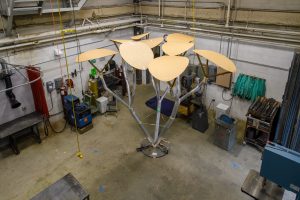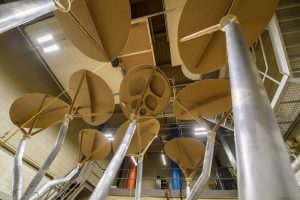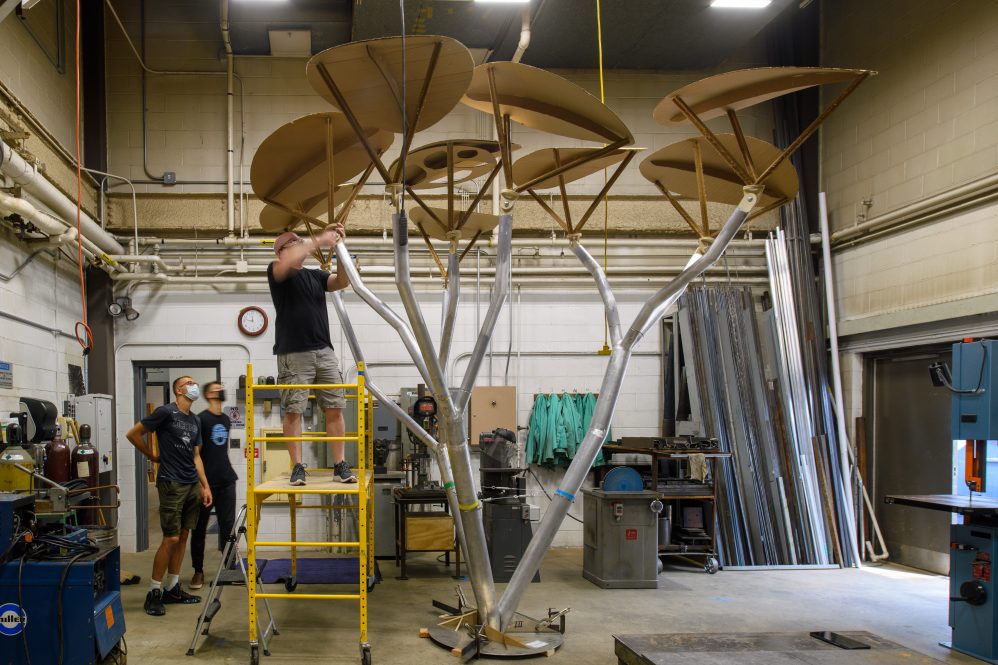Most Americans are familiar with the sight of a solar panel on a house or in a field. They know what solar power is, but may not really have a direct experience with using it.
An interdisciplinary group of UConn faculty and students are looking to change that by constructing a “solar tree” and installing it in on campus.

A solar tree usually consists of a metal base that supports panels to look like an actual tree. The solar power generated from the panels is stored in batteries, which allows users to charge personal electronic devices, like mobile phones. The technology is common in Europe and Asia, with growing numbers of solar trees in the US.
The UConn project is known as a “STEAM” tree because it combines the skills of University members from science, technology, engineering, arts, and mathematics.
“The biggest attractor of this project for me is getting to work with a group of people that I really didn’t know before and to work with people across different divisions,” says Chris Sancomb, an assistant professor in the newly created Industrial Design program in the School of Fine Arts. “Work like this was one of the reasons I came to UConn as a faculty member.”
The UConn solar tree is currently being constructed in a studio in the School of Fine Arts Building, and a site for the tree on campus is still being finalized. The hope is that the tree will be ready for use on campus sometime in October.
“We see this solar tree as a combination of artistic design, engineering design, and a social gathering place,” says Jasna Jankovic, an assistant professor in the Department of Materials Science and Engineering, who initiated the idea of a solar tree on the UConn Storrs campus.
Although there are a few other solar trees on university campuses, it is believed that UConn’s solar tree will be the first on a college campus in the United States constructed solely by university faculty and students. Also, it will be the only portable solar tree that can be fully disassembled and reassembled, to be placed in various locations on and off campus.
“Solar power is a distant thing that you can sort of see, but you don’t actually benefit from directly,” says Sancomb. “We thought it would be useful with the tree to show a direct correlation between the solar energy generated and your ability to access it. So, our tree is designed so that people can walk right up to it and plug in.”
The tree will have a dozen USB ports, and is almost completely made up of structural aluminum.
“We are building the tree by cutting, welding, and bending, and using a lot of different kinds of fabricating,” says Sancomb. “We are also using 3-D printing here and there for samples, and proof concepts that will later be manufactured out of aluminum. It is all made here on campus and the material has been sourced locally.”
The funding for the solar tree came from a UConn STEAM Innovation Grant, while batteries and solar panels were donated by Renogy.

“We imagine that the tree will be both a gathering place, and also a place where outdoor lectures can happen or even virtual lessons, where students can access their lessons through solar power,” says Jankovic.
The use of batteries in the solar tree is an important part of educating people about solar power.
“Sunlight is not all that consistent to provide electricity, so we store energy to batteries and the electricity to the charging ports,” says Sung Yeul Park, an associate professor in the Department of Electrical and Computer Engineering.
As the tree is being constructed, various sites on campus are being considered for optimal use.
UConn graduate student Michelle Skowronek ’20 (CLAS) is currently working on her masters of public administration degree, and did research into criteria like visibility, accessibility, walkability, the number of people that would pass the tree, and traffic flow.
“A group of us got together and identified probably half a dozen good sites on campus,” says Cindy Jones, a professor in the Department of Ecology and Evolutionary Biology.
The professors believe that a collaborative project like the solar tree will be the start of more projects like it at UConn, and will assist in their teaching and research. The tree will serve research as a “living lab,” and will enable the faculty and students to perform research with the tree – in areas like materials science, arts, biology, engineering, and social science.
“The education and research component are, beside the social place-making, the most important aspect of the tree,” says Jankovic.
“The work I have done just in my individual area will have a huge teaching aspect,” says Sancomb. “There are parts that I have generated that I can show students, and show them how I got to that point and show them a decision-making process. The solar tree is a great teaching tool for me.”



